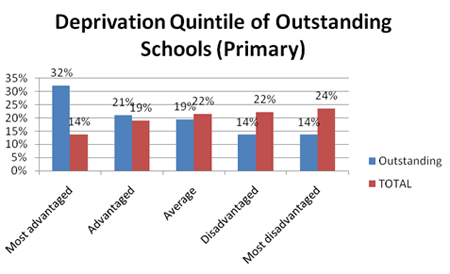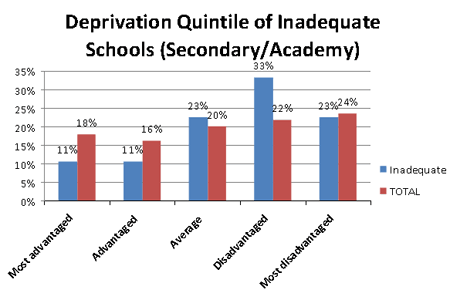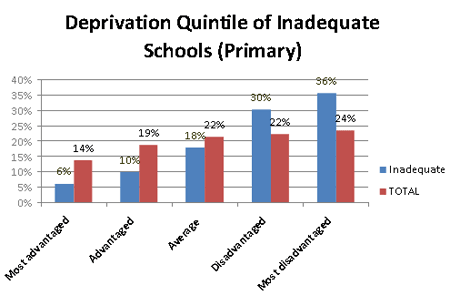Dr Ruth Lupton FRSA from the London School of Economics and Political Science analyses the relationship between school quality and poverty.
The Coalition government is committed to reducing inequalities in educational outcomes between rich and poor, particularly through its pupil premium. It also believes that educational standards will improve if schools are allowed to be more independent and more diverse in what they offer, hence its New Academies and Free School Policies.
These two goals may prove to be at odds for a number of reasons, not least that greater diversity and choice tends to advantage those families who have the knowledge and desire to make choices, and/or the resources to move near the best schools. A more immediate concern is that the Coalition is extending these new freedoms using a ‘best first' approach. At the moment, only those schools judged ‘outstanding' by Ofsted can apply to become Academies.
According to the RSA's director of education, Professor Becky Francis, this is "an odd way to further social justice", since it is "further helping already thriving schools with already thriving pupils". Whether or not she is right depends on the location and socio-economic composition of outstanding schools: are they really in the most advantaged areas with the most advantaged intakes, or can they also be found in poorer areas where educational outcomes are most in need of improvement? In this note I examine this question using Ofsted inspection data matched to the Index of Deprivation Affecting Children (IDACI) for pupils attending the school.
The analysis is based on data supplied by Ofsted for all schools inspected in Autumn 2009 and Spring 2010: 592 secondary schools (including existing Academies) and 2971 primary schools. This represents a little under a fifth of all schools in number, although biased towards those thought to be satisfactory, inadequate or declining, since this is where Ofsted targeted its 2009/10 inspection resources. Ofsted divides the schools into quintiles (5ths) based on their IDACI scores. IDACI provides a combined score for every small area based on the proportion of children from low income families. Each child in a school is allocated the IDACI score for the area in which (s)he lives, and for any given school, the average of the pupils' scores is calculated to give a school-level score.
Ofsted grades each school ‘outstanding', ‘good', ‘satisfactory' or ‘inadequate'. The majority of schools in this 2009/10 sample were either ‘good' or ‘satisfactory'. Around 10 percent were graded ‘outstanding' and a similar proportion ‘inadequate'. The proportion ‘inadequate' is rather higher than for all schools, and the proportion ‘outstanding' rather lower, reflecting the targeting of inspections to schools with greater difficulties.
The data show that schools judged to be outstanding when they were inspected in Autumn/Spring 2009/2010 were disproportionately likely to have advantaged intakes. The pattern was more marked at primary than at secondary level. A third (33 percent) of outstanding secondary schools were in the most advantaged fifth on the IDACI measure, compared with 18 percent of schools overall. Interestingly, 24 percent were in the most disadvantaged fifth. Schools in the middle three quintiles were all under-represented among outstanding schools (Figure 1).

Similarly almost a third (32 percent) of outstanding primary schools were in the most advantaged fifth, compared with 14 percent of schools in the sample overall. However, for primary schools there was a more predictable social gradient. Schools in the second most advantaged quintile were also over-represented among outstanding schools, whereas all other groups were underrepresented, especially the most disadvantaged schools. Only 14 percent of outstanding schools were in the most disadvantaged fifth compared with 24 percent of schools overall (Figure 2).

Figure 2: Deprivation Quintile of Outstanding Primary Schools
In theory then, policies that benefit outstanding schools are more likely to help the most socially advantaged schools. However, what actually happens depends on which schools actually elect to take up the new status. In September 2010 35 outstanding schools became Academies. Of these over half were in the most advantaged two-fifths. Only three were in the most disadvantaged fifth. While these numbers are too small to provide any statistical reliability, they certainly suggest that the process of selecting into Academy status is not, at least yet, resulting in any skew towards the poorer schools.
Ofsted's data also tells another important story. Schools adjudged to be ‘inadequate' at their inspection in 2009/10 were disproportionately located in poorer areas. Among secondary schools, ‘inadequate‘ schools were under-represented in the most advantaged two quintiles and also (marginally) in the most disadvantaged fifth (Figure 4). They were, however, significantly over-represented in the fourth quintile. This pattern may reflect the recent policy effort directed at ‘failing' secondary schools in the poorest areas. Among primary schools, there was a more marked pattern. Inadequate schools were under-represented in the more advantaged three quintiles and over-represented in the more disadvantaged two (Figure 4).

Figure 3: Deprivation Quintile of Inadequate Secondary Schools
Bringing all the sampled schools into the picture, the socio-economic gradient of school quality was more clearly evident. 66 percent of secondary/academy schools in the most disadvantaged quintile and 67 percent in the next quintile were ‘satisfactory' or ‘inadequate', compared with just 34 percent in the most advantaged quintile. For primary schools the equivalent figures were 58 percent, 57 percent and 28 percent.
Some headteachers argue that this is because the inspection criteria make it hard for poorer schools to excel, but even if we accept the Ofsted judgements as a true reflection of quality, there are numerous reasons why quality might be lower in disadvantaged areas, including staff recruitment problems and turnover, difficulty forging positive home-school partnerships, and the more emotionally demanding and contested environments that absorb staff time and make it harder to create good environments for teaching and learning.
In this context, granting Academy status to outstanding schools seems to be missing the point in terms of addressing educational inequality. Rather than tinkering with the top end of the system, the government needs to maintain Labour's drive to improve the schools at the bottom. My view is that this will require more than a pupil premium. Money may well need to be directed to individual disadvantaged pupils, but it also needs to be spent equalising institutional conditions, dealing with issues that affect all pupils such as consistency and quality of staffing. Unless the school quality gap can be closed, the achievement gap will not be. The Coalition's ‘best first' approach is indeed an odd way to further social justice.
Dr Ruth Lupton FRSA is from the London School of Economics and Political Science.



vietnamvisa
18th June 2013
thank a lot, it's a great report, thanks for sharing with us.
SEO Chester
14th July 2011
This is a great detailed report, lots of thought must have gone into this, great stuff!
terrik
25th November 2010
An underlying issue not made very clear in the article is that to be 'outstanding' schools now have to have - whatever their intake - a high and improving level of achievement in examinations. Even a high added value is not enough. High achievement is often related to the employment of private tutors. Therefore, the outstanding school status is really partly based upon the parents' ability to pay and not the perfomance of the school or the teaching at all. So state funding is being concentrated upon schools in more affluent areas who may not need it, money following money, as the article states. Where is the evidence for your statement Gfpanayiotou?
Gfpanayiotou
24th November 2010
We face the danger of neglecting the "best schools" and "best students" in trying to deal with the disadvantaged pupils.
alan mills
17th November 2010
An excellent and well supported article. The pupil premium isn't new money as it is taken from elsewhere in the DfE budget. The change in policy not mentioned in the article, is that all schools can now apply for academy status. The problem is that alongside this opportunity is the Free Schools disaster. Schools with no real technology or play space and teachers who do not need to be qualified or trained are a real possibility. The disadvantaged will not thrive in this new environment.